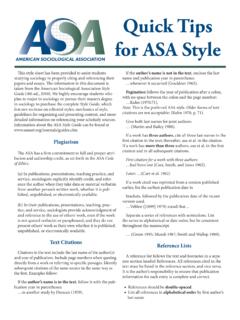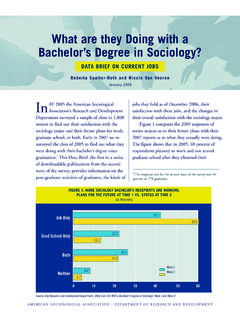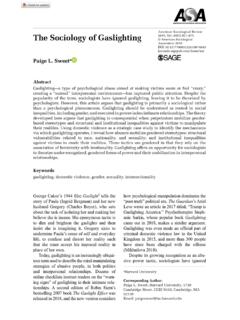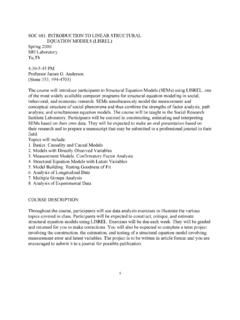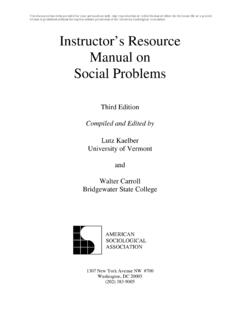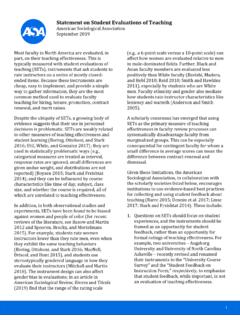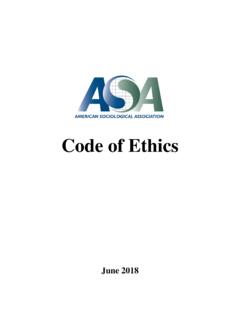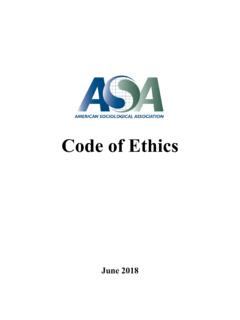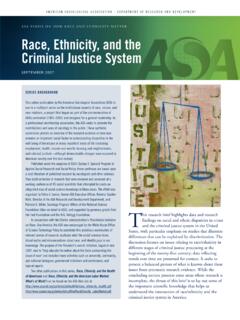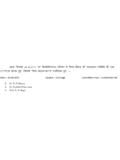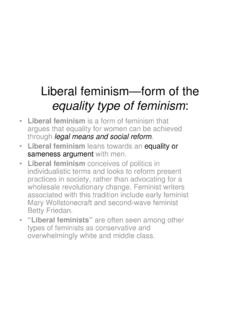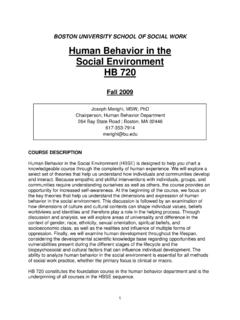Transcription of Teaching Sociology Measuring Student Learning …
1 Teaching Sociology2014, Vol. 42(3) 231 239 American Sociological Association 2014 DOI: baccalaureate degree curricula of most under-graduate Sociology and other social science pro-grams require one or more courses in statistics. Despite the importance of quantitative data analysis in these disciplines, students with limited mathemat-ics backgrounds and anxiety over statistics present a challenge to professors Teaching these courses (Bandalos, Finney, and Geske 2003; Blalock 1987; Cerrito 1999; Forte 1995; Garfield and Chance 2000; Macheski et al.)
2 2008; Wilder 2010). Not sur-prisingly, faculty assigned to teach statistics search for approaches that improve students statistical skills. Numerous classroom techniques ( , small-group work, collaborative testing, humor, computer-assisted instruction, active Learning , etc.) have been described in college statistics courses (Delucchi 2006; Helmericks 1993; Schacht and Stewart 1990; Schumm et al. 2002; Strangfeld 2013). Faculty using these practices report greater Student satisfac-tion with the course (Fischer 1996; Perkins and Saris 2001; Potter 1995; Stork 2003), reduction of anxiety (DeCesare 2007; Lomax and Moosavi 2002), and a belief that Learning was greater than students could have achieved without the instructional innovation (Auster 2000; Wybraniec and Wilmoth 1999; Yamarik 2007).
3 Upon close review, many of these studies pro-vide little or no (direct assessment) empirical evi-dence that students statistics skills and knowledge ( , Learning ) actually increased because of the Teaching strategy. Assessment is subjective and fre-quently relies on the perceptions of students or fac-ulty (Fisher-Giorlando 1992; Lomax and Moosavi 2002; Marson 2007; Schacht and Stewart 1992). While not without some merit, comments based on SociologyDelucchiresearch-article20141 University of Hawaii, Kapolei, USAC orresponding Author:Michael Delucchi, Division of Social Science, University of Hawaii, 91-1001 Farrington Highway, Kapolei, HI 96707, USA.
4 Email: Student Learning in Social Statistics: A Pretest-Posttest Study of Knowledge GainMichael Delucchi1 AbstractThis study used a pretest-posttest design to measure Student Learning in undergraduate statistics. Data were derived from 185 students enrolled in six different sections of a social statistics course taught over a seven-year period by the same Sociology instructor. The pretest-posttest instrument reveals statistically significant gains in knowledge for each course section and all sections combined.
5 The results demonstrate that pretests can establish students prior knowledge at the beginning of the semester, while posttests measure Learning at the end of the course. Namely, pretest-posttest knowledge gain was influenced more by the content and presentation of the social statistics course than by students statistical ability and/or test-taking skills prior to the class. Recommendations on the use of pretest-posttest data to inform pedagogy in social statistics are included in the assessment, Student Learning , knowledge gain, social statistics at ASA - American Sociological Association on July 2, from 232 Teaching Sociology 42(3)informal impressions, and even quantitative mea-sures of course satisfaction ( , Student evalua-tions of Teaching or alumni surveys), do not directly signify Student Learning .
6 As indicators of perceived knowledge (rather than actual knowledge), these indirect methods of assessment are limited because assumptions must be made about what such self-reports mean (Price and Randall 2008). students academic performance, such as exami-nation scores and course grades, as a proxy for learn-ing (Borresen 1990; Delucchi 2007; Perkins and Saris 2001; Smith 2003; Yamarik 2007) also does not represent direct evidence of Learning (Baker 1985; Chin 2002; Garfield and Chance 2000; Lucal et al.)
7 2003; Wagenaar 2002; Weiss 2002). Why not? Learning is different from performance. Learning is increased knowledge: that is, the difference between what students know at the beginning of the semester compared with the end of the semester. Performance is demonstrating mastery: for example, accurate computation of a statistic or a correct answer to a multiple-choice question. This distinction between Learning and performance is important since stu-dents enter courses with unequal knowledge, skills, and educational experiences.
8 For instance, a Student may begin the semester knowing little, learn a great deal, perform adequately, and receive average grades, or a Student may enter a course knowing a great deal, learn a small amount, perform very well, and earn high grades (Neuman 1989). Consequently, pretests are necessary to establish prior knowledge, and posttests are requisite to measure assessment of Student Learning in under-graduate statistics courses, based on pretests and posttests, is rare (Bridges et al.)
9 1998; Price and Randall 2008). An objective of this study is to eval-uate the effect of course completion on students statistical knowledge. Therefore, I use a pretest-posttest design to measure students prior course knowledge and to measure Learning at the end of the semester. This method of assessment is pro-ceeded by recommendations on the use of pretest-posttest data to inform pedagogy in undergraduate social AND METHODSI nstitutional ContextThe study was conducted at a small (approximately 1,500 students ) state-supported baccalaureate degree granting university in the United States.
10 The Carnegie classification describes the institu-tion as a Baccalaureate College Liberal Arts (McCormick 2001). The institution is coeduca-tional (68 percent women; 32 percent men), ethni-cally diverse (59 percent ethnic minorities), and comprised predominantly of students of nontradi-tional age (65 percent are 25 years of age or older). Eighty-two percent of students are employed (40 percent working more than 31 hours per week), and all students commute to the DescriptionStatistical Analysis is an undergraduate course taught in the Division of Social Sciences.
